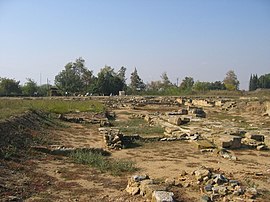Abdera, Thrace
|
Abdera Άβδηρα |
|
|---|---|

Remains of the ancient city of Abdera.
|
|
| Coordinates: 40°56′N 24°58′E / 40.933°N 24.967°ECoordinates: 40°56′N 24°58′E / 40.933°N 24.967°E | |
| Country | Greece |
| Administrative region | East Macedonia and Thrace |
| Regional unit | Xanthi |
| Area | |
| • Municipality | 352.0 km2 (135.9 sq mi) |
| • Municipal unit | 162.0 km2 (62.5 sq mi) |
| Elevation | 41 m (135 ft) |
| Population (2011) | |
| • Municipality | 19,005 |
| • Municipality density | 54/km2 (140/sq mi) |
| • Municipal unit | 3,341 |
| • Municipal unit density | 21/km2 (53/sq mi) |
| Community | |
| • Population | 1,473 (2011) |
| Time zone | EET (UTC+2) |
| • Summer (DST) | EEST (UTC+3) |
| Vehicle registration | AH |
Abdera (/əbˈdɪrə/; Ancient Greek: Ἄβδηρα) was a major Greek polis on the coast of Thrace. It lay 17 km east-northeast of the mouth of the Nestos River, almost directly opposite the island of Thasos. The site now lies in the Xanthi regional unit of Thrace, Greece. The municipality of Abdera (Modern Greek: Άβδηρα [ˈavðira]) has 19,005 inhabitants (2011). The seat of the municipality is the town Genisea.
Its mythical foundation was attributed to Heracles who founded the city on behalf of his fallen friend Abderus. The historical founding is traced back to a colony from Klazomenai. This historical founding was traditionally dated to 654 BC, which is unverified, although evidence in 7th century BC Greek pottery tends to support it. But its prosperity dates from 544 BC, when the majority of the people of Teos (including the poet Anacreon) migrated to Abdera to escape the Persian yoke (Herodotus i.168). The chief coin type, a griffon, is identical with that of Teos; the rich silver coinage is noted for the beauty and variety of its reverse types.
...
Wikipedia


